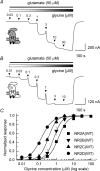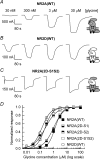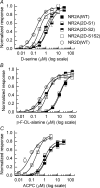Modulation of glycine potency in rat recombinant NMDA receptors containing chimeric NR2A/2D subunits expressed in Xenopus laevis oocytes
- PMID: 17962328
- PMCID: PMC2375544
- DOI: 10.1113/jphysiol.2007.143172
Modulation of glycine potency in rat recombinant NMDA receptors containing chimeric NR2A/2D subunits expressed in Xenopus laevis oocytes
Abstract
Heteromeric NMDARs are composed of coagonist glycine-binding NR1 subunits and glutamate-binding NR2 subunits. The majority of functional NMDARs in the mammalian central nervous system (CNS) contain two NR1 subunits and two NR2 subunits of which there are four types (A-D). We show that the potency of a variety of endogenous and synthetic glycine-site coagonists varies between recombinant NMDARs such that the highest potency is seen at NR2D-containing and the lowest at NR2A-containing NMDARs. This heterogeneity is specified by the particular NR2 subunit within the NMDAR complex since the glycine-binding NR1 subunit is common to all NMDARs investigated. To identify the molecular determinants responsible for this heterogeneity, we generated chimeric NR2A/2D subunits where we exchanged the S1 and S2 regions that form the ligand-binding domains and coexpressed these with NR1 subunits in Xenopus laevis oocytes. Glycine concentration-response curves for NMDARs containing NR2A subunits including the NR2D S1 region gave mean glycine EC(50) values similar to NR2A(WT)-containing NMDARs. However, receptors containing NR2A subunits including the NR2D S2 region or both NR2D S1 and S2 regions gave glycine potencies similar to those seen in NR2D(WT)-containing NMDARs. In particular, two residues in the S2 region of the NR2A subunit (Lys719 and Tyr735) when mutated to the corresponding residues found in the NR2D subunit influence glycine potency. We conclude that the variation in glycine potency is caused by interactions between the NR1 and NR2 ligand-binding domains that occur following agonist binding and which may be involved in the initial conformation changes that determine channel gating.
Figures










Similar articles
-
Mg2+ and memantine block of rat recombinant NMDA receptors containing chimeric NR2A/2D subunits expressed in Xenopus laevis oocytes.J Physiol. 2008 Jan 1;586(1):211-25. doi: 10.1113/jphysiol.2007.143164. Epub 2007 Oct 25. J Physiol. 2008. PMID: 17962329 Free PMC article.
-
Pharmacological characterization of recombinant NR1/NR2A NMDA receptors with truncated and deleted carboxy termini expressed in Xenopus laevis oocytes.Br J Pharmacol. 2009 Feb;156(3):509-18. doi: 10.1111/j.1476-5381.2008.00040.x. Epub 2009 Jan 16. Br J Pharmacol. 2009. PMID: 19154422 Free PMC article.
-
Single channel analysis of a novel NMDA channel from Xenopus oocytes expressing recombinant NR1a, NR2A and NR2D subunits.J Physiol. 2000 Aug 1;526 Pt 3:481-91. J Physiol. 2000. PMID: 10922001
-
N-[2-(N-(2-mercaptoethyl)) amino ethyl]-N-(2-mercaptoethyl)-3,5-dimethylacetamide amantadine-technetium.2012 Jun 12 [updated 2012 Jul 17]. In: Molecular Imaging and Contrast Agent Database (MICAD) [Internet]. Bethesda (MD): National Center for Biotechnology Information (US); 2004–2013. 2012 Jun 12 [updated 2012 Jul 17]. In: Molecular Imaging and Contrast Agent Database (MICAD) [Internet]. Bethesda (MD): National Center for Biotechnology Information (US); 2004–2013. PMID: 22812023 Free Books & Documents. Review.
-
Influence of the NR3A subunit on NMDA receptor functions.Prog Neurobiol. 2010 May;91(1):23-37. doi: 10.1016/j.pneurobio.2010.01.004. Epub 2010 Jan 25. Prog Neurobiol. 2010. PMID: 20097255 Free PMC article. Review.
Cited by
-
Structural Basis of Functional Transitions in Mammalian NMDA Receptors.Cell. 2020 Jul 23;182(2):357-371.e13. doi: 10.1016/j.cell.2020.05.052. Epub 2020 Jun 30. Cell. 2020. PMID: 32610085 Free PMC article.
-
Potential Roles for the GluN2D NMDA Receptor Subunit in Schizophrenia.Int J Mol Sci. 2023 Jul 23;24(14):11835. doi: 10.3390/ijms241411835. Int J Mol Sci. 2023. PMID: 37511595 Free PMC article. Review.
-
Structural determinants and mechanism of action of a GluN2C-selective NMDA receptor positive allosteric modulator.Mol Pharmacol. 2014 Nov;86(5):548-60. doi: 10.1124/mol.114.094516. Epub 2014 Sep 9. Mol Pharmacol. 2014. PMID: 25205677 Free PMC article.
-
Activation of EphA receptors mediates the recruitment of the adaptor protein Slap, contributing to the downregulation of N-methyl-D-aspartate receptors.Mol Cell Biol. 2013 Apr;33(7):1442-55. doi: 10.1128/MCB.01618-12. Epub 2013 Feb 4. Mol Cell Biol. 2013. PMID: 23382070 Free PMC article.
-
A computer-based quantitative systems pharmacology model of negative symptoms in schizophrenia: exploring glycine modulation of excitation-inhibition balance.Front Pharmacol. 2014 Oct 21;5:229. doi: 10.3389/fphar.2014.00229. eCollection 2014. Front Pharmacol. 2014. PMID: 25374541 Free PMC article.
References
-
- Banke TG, Traynelis SF. Activation of NR1/NR2B NMDA receptors. Nat Neurosci. 2003;6:144–152. - PubMed
-
- Baron BM, Harrison BL, Miller FP, McDonald IA, Salituro FG, Schmidt CJ, Sorensen SM, White HS, Palfreyman MG. Activity of 5,7-dichlorokynurenic acid, a potent antagonist at the N-methyl-D-aspartate receptor-associated glycine binding site. Mol Pharmacol. 1990;38:554–561. - PubMed
Publication types
MeSH terms
Substances
Grants and funding
LinkOut - more resources
Full Text Sources
Molecular Biology Databases

